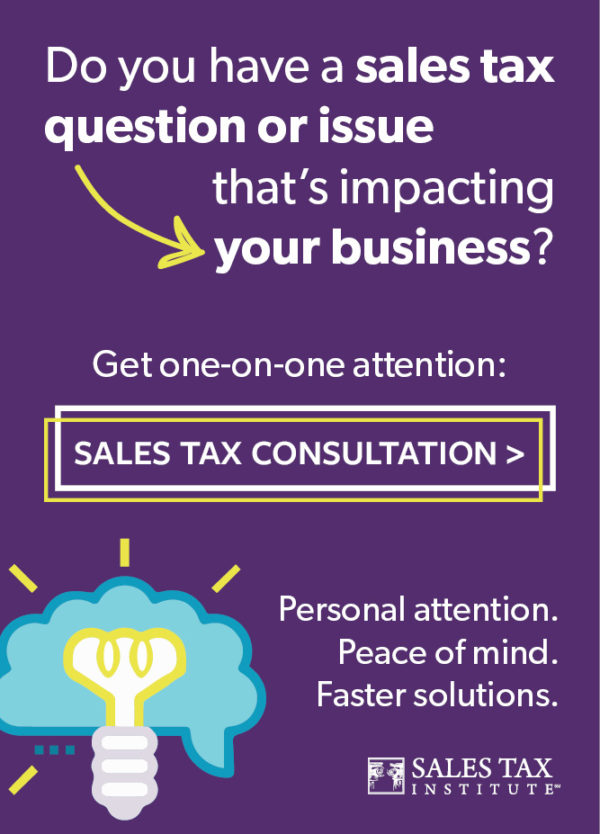What is Sales Tax Compliance and How Do I Do It?
At the Sales Tax Institute, we are frequently asked about “how to do sales tax.” In other words, how does one stay sales tax compliant?
In short, sales tax compliance is preparing and filing sales and use tax returns. Once a taxpayer is registered to collect or pay sales and use taxes in a jurisdiction, returns must be filed and the tax must be remitted on a timely basis.
Sales tax compliance can be viewed as an 8-step process. See below for the 8 steps and a short summary of what each step entails.
1. Gather the Data
In order to properly complete a sales or use tax return, you’ll need to gather data from many different sources within the company. If you work for a larger company, you’ll need to team with various departments. Key departments include engineering, marketing, legal, corporate secretary, and operations.
Sales and use tax data has many different origins and is generated in different financial processes. Data can exist in numerous sources, including the sales journal, accounts payable journal, fixed assets ledgers, and many more.
2. Evaluate and Reconcile the Data
Gathering data from various departments can create challenges in evaluating and reconciling the data. The different reports and data must be consolidated for reporting. There are a number of tools you can use to make this process easier, including Microsoft Access, Microsoft Excel, and more.
You’ll need to reconcile the data as well. Some items to consider when reconciling the data are:
- Sales tax collected
- Use tax accrued
- Tax collected vs. tax due
3. Populate the Tax Return
Once you’ve gathered all the necessary data, you need to input the information into the tax forms. A review of the tax returns is necessary to understand what is required and how it is to be presented.
Note that return preparation varies by state. Sales data is reported separately from purchase data. In some states, this could be on a separate return, while on others it could just be separate lines on the same return. Other differences could include sales vs. seller’s use, rental/lease, telecommunications, and other special tax types.
4. File the Tax Return & Pay Tax
Once you’ve prepared the return, it must be filed on a timely basis and the tax must be remitted to the taxing jurisdiction. The jurisdiction will inform you of your filing frequency and due date. Note that the due date applies to both the filing of the return and the payment of the tax.
Sales tax returns are generally due in the month following the taxable event. Due dates vary by jurisdiction. Common due dates are the 15th, 20th, 25th and end of the month. Note that different due dates may apply for EFT (Electronic Funds Transfer) filers than for check payment filers.
5. Reconcile Bank/Confirm Payments
Once you’ve submitted the tax payment, you should confirm that payment was received and processed by the state Department of Revenue. You should also prepare a bank reconciliation to confirm that payment clears for the proper amount.
6. Calendar Update
It is a best practice to create a “Tax Calendar” spreadsheet for tracking important filing information such as due dates, the tax due, who prepared the return, the filing method, date filed, the filing and payment confirmation numbers and more.
Once you’ve prepared this tax calendar, make sure to update it after you file every return. This way it is easier to go back and trace your steps or to show confirmation that a return was filed and payment was made.
7. Respond to Notices
Notices are generated by taxing authorities when errors occur. Many notices have short response times associated with them and require prompt attention. When responding to notices, it is important to provide all the documentation to the taxing jurisdiction. Once a response to a notice has been sent, it should be tracked until resolution has been confirmed.
8. Repeat!
Sales tax compliance is an ongoing process. Once you’ve established the 7 previous steps, it’s a matter of repeating and making tweaks as necessary. We hope this information is helpful in explaining “how to do sales tax.”
Looking for More Information? Check out the Following Resources:
- Download our free Important Concepts in Sales Tax Administration whitepaper
- Learn the best ways to conduct tax research with the Save Time & Eliminate Guesswork with Effective Tax Research Webinar On-Demand
